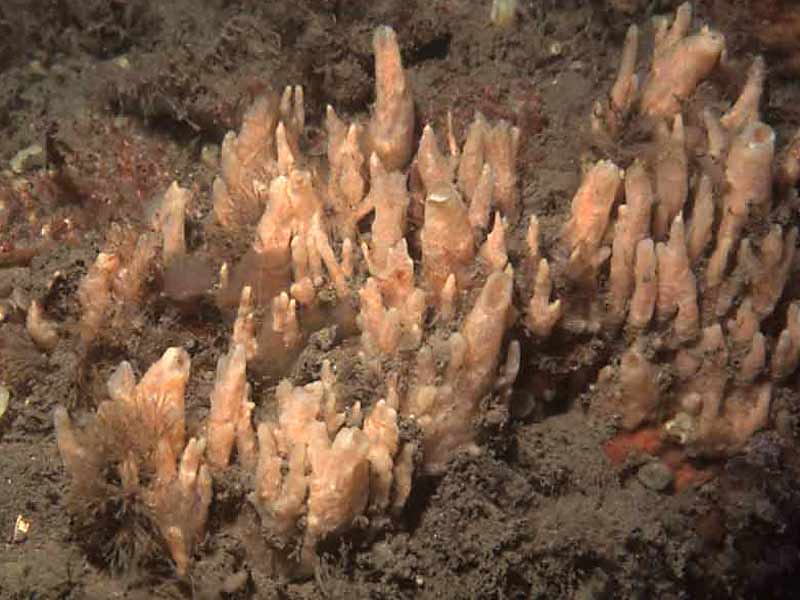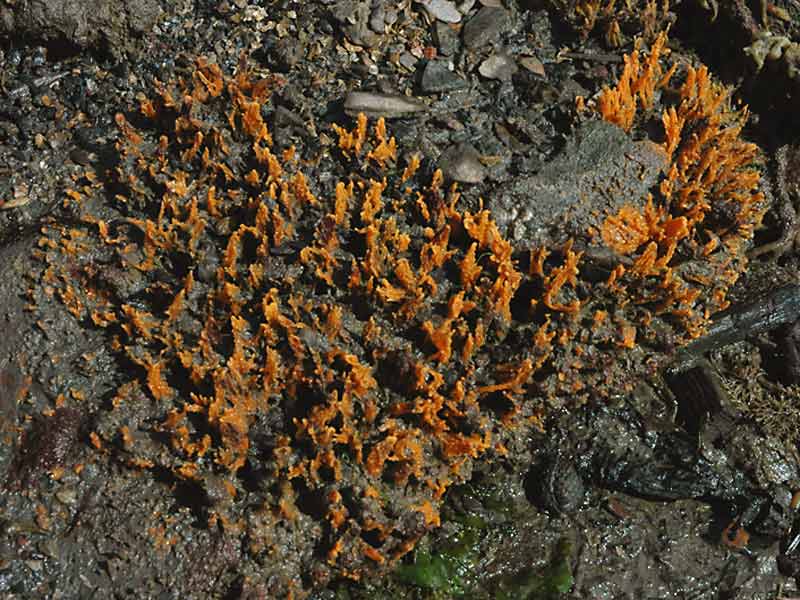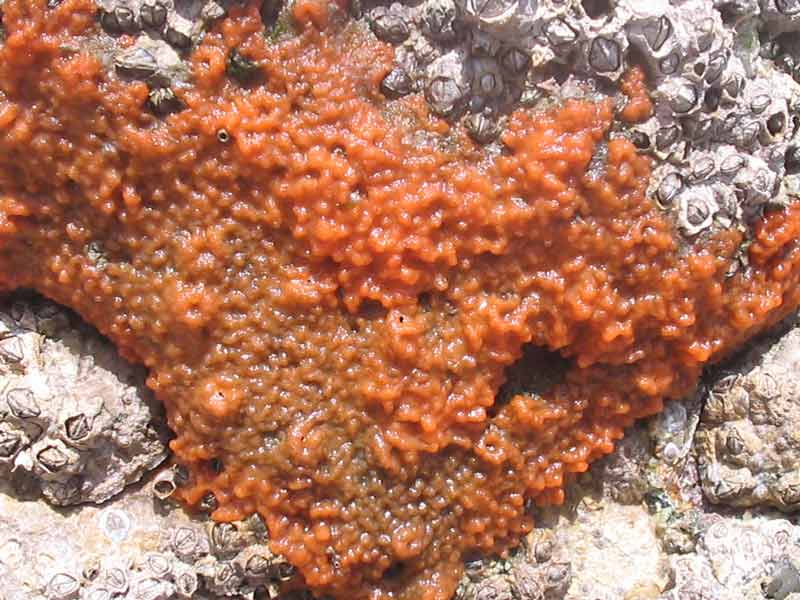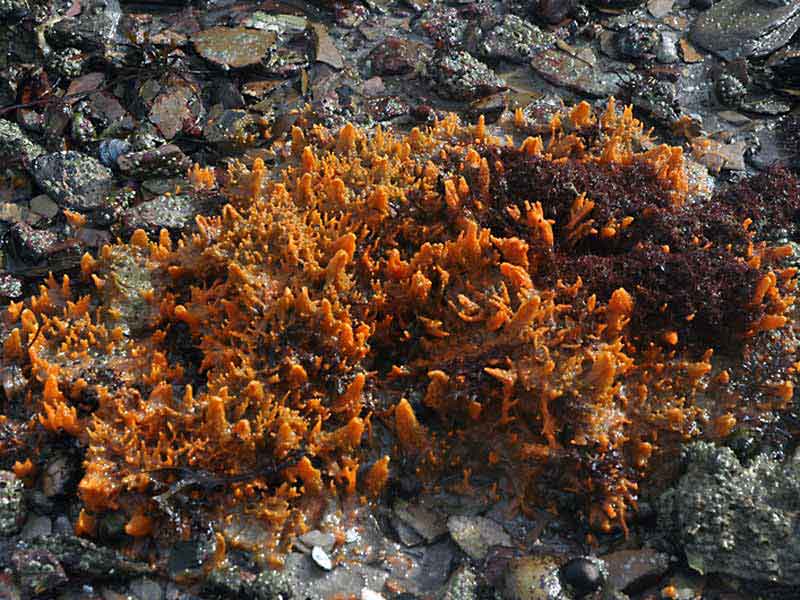Crumb-of-bread sponge (Hymeniacidon perlevis)
Distribution data supplied by the Ocean Biodiversity Information System (OBIS). To interrogate UK data visit the NBN Atlas.Map Help
| Researched by | Elizabeth Barton | Refereed by | Admin |
| Authority | (Montagu, 1814) | ||
| Other common names | - | Synonyms | Hymeniacidon perlevis , Hymeniacidon perlevis (Montagu, 1814), Hymeniacidon perleve |
Summary
Description
The growth form and colour of Hymeniacidon perlevis varies depending upon shore exposure, from thin sheets on lower to mid shore (growing along crevices and fault lines), to massive flanged or turreted forms often found on the lower shore in wave sheltered locations and in the sublittoral where conditions are distinctly silty. Colour varies from yellow to orange to blood-red. Shore forms tend to be blood-red, whilst sublittoral forms tend to be pinkish-red.
Recorded distribution in Britain and Ireland
Recorded from Shetland, Orkney, a few scattered locations on the east coast, but more abundant on the south, south west and west coasts of Britain. It has also been recorded from the River Ilen estuary in southern Ireland.Global distribution
-Habitat
Usually an intertidal species found colonizing a variety of surfaces from exposed rocks and seaweed holdfasts to muddy gravel. Also present on sublittoral rocks in turbid water or variable salinity conditions. It appears to prefer slightly silty environments.Depth range
-Identifying features
- Grows as thin sheets, 'cushions' or massive flanged, but rarely branching.
- Grows up to 20 cm or more across.
- Thickness varies from a few mm (usually <0.03 cm) to 10 cm or more.
- Flanges and irregular projections may grow up to 3 cm or more.
- Yellow to orange to blood-red in colour.
- Surface smooth, even and minutely tuberculate in thin sheets, even but distinctly tuberculate in 'cushions' and uneven, irregularly folded with well developed tubercles in flanged forms.
- Smells sweetish, but vaguely distasteful.
- Oscules (openings) are scattered, level with surface or at the top of branching processes.
Additional information
In the intertidal and shallow sublittoral more than one form can be detected, which may eventually be recognized as including more than one distinct species.
Other species
Hymeniacidon kitchingi is the only other Hymeniacidon species from Western Europe. It is more thinly encrusting than Hymeniacidon perlevis, and is beige-yellowish in colour. Close examination of the spicules of the endoskeleton may be required to distinguish other species.
Listed by
- none -
Bibliography
Fish, J.D. & Fish, S., 1996. A student's guide to the seashore. Cambridge: Cambridge University Press.
Howson, C.M. & Picton, B.E., 1997. The species directory of the marine fauna and flora of the British Isles and surrounding seas. Belfast: Ulster Museum. [Ulster Museum publication, no. 276.]
Van Soest, R.W.M., Picton, B. & Morrow, C., 2000. Sponges of the North East Atlantic. [CD-ROM] Windows version 1.0. Amsterdam: Biodiversity Center of ETI, Multimedia Interactive Software. [World Biodiversity Database CD-ROM Series.]
Datasets
Centre for Environmental Data and Recording, 2018. Ulster Museum Marine Surveys of Northern Ireland Coastal Waters. Occurrence dataset https://www.nmni.com/CEDaR/CEDaR-Centre-for-Environmental-Data-and-Recording.aspx accessed via NBNAtlas.org on 2018-09-25.
Cofnod – North Wales Environmental Information Service, 2018. Miscellaneous records held on the Cofnod database. Occurrence dataset: https://doi.org/10.15468/hcgqsi accessed via GBIF.org on 2018-09-25.
Fenwick, 2018. Aphotomarine. Occurrence dataset http://www.aphotomarine.com/index.html Accessed via NBNAtlas.org on 2018-10-01
Kent Wildlife Trust, 2018. Biological survey of the intertidal chalk reefs between Folkestone Warren and Kingsdown, Kent 2009-2011. Occurrence dataset: https://www.kentwildlifetrust.org.uk/ accessed via NBNAtlas.org on 2018-10-01.
Kent Wildlife Trust, 2018. Kent Wildlife Trust Shoresearch Intertidal Survey 2004 onwards. Occurrence dataset: https://www.kentwildlifetrust.org.uk/ accessed via NBNAtlas.org on 2018-10-01.
Manx Biological Recording Partnership, 2017. Isle of Man wildlife records from 01/01/2000 to 13/02/2017. Occurrence dataset: https://doi.org/10.15468/mopwow accessed via GBIF.org on 2018-10-01.
Manx Biological Recording Partnership, 2018. Isle of Man historical wildlife records 1995 to 1999. Occurrence dataset: https://doi.org/10.15468/lo2tge accessed via GBIF.org on 2018-10-01.
National Trust, 2017. National Trust Species Records. Occurrence dataset: https://doi.org/10.15468/opc6g1 accessed via GBIF.org on 2018-10-01.
NBN (National Biodiversity Network) Atlas. Available from: https://www.nbnatlas.org.
OBIS (Ocean Biodiversity Information System), 2025. Global map of species distribution using gridded data. Available from: Ocean Biogeographic Information System. www.iobis.org. Accessed: 2025-07-24
Outer Hebrides Biological Recording, 2018. Invertebrates (except insects), Outer Hebrides. Occurrence dataset: https://doi.org/10.15468/hpavud accessed via GBIF.org on 2018-10-01.
South East Wales Biodiversity Records Centre, 2023. SEWBReC Marine and other Aquatic Invertebrates (South East Wales). Occurrence dataset:https://doi.org/10.15468/zxy1n6 accessed via GBIF.org on 2024-09-27.
Yorkshire Wildlife Trust, 2018. Yorkshire Wildlife Trust Shoresearch. Occurrence dataset: https://doi.org/10.15468/1nw3ch accessed via GBIF.org on 2018-10-02.
Citation
This review can be cited as:
Last Updated: 29/04/2008







